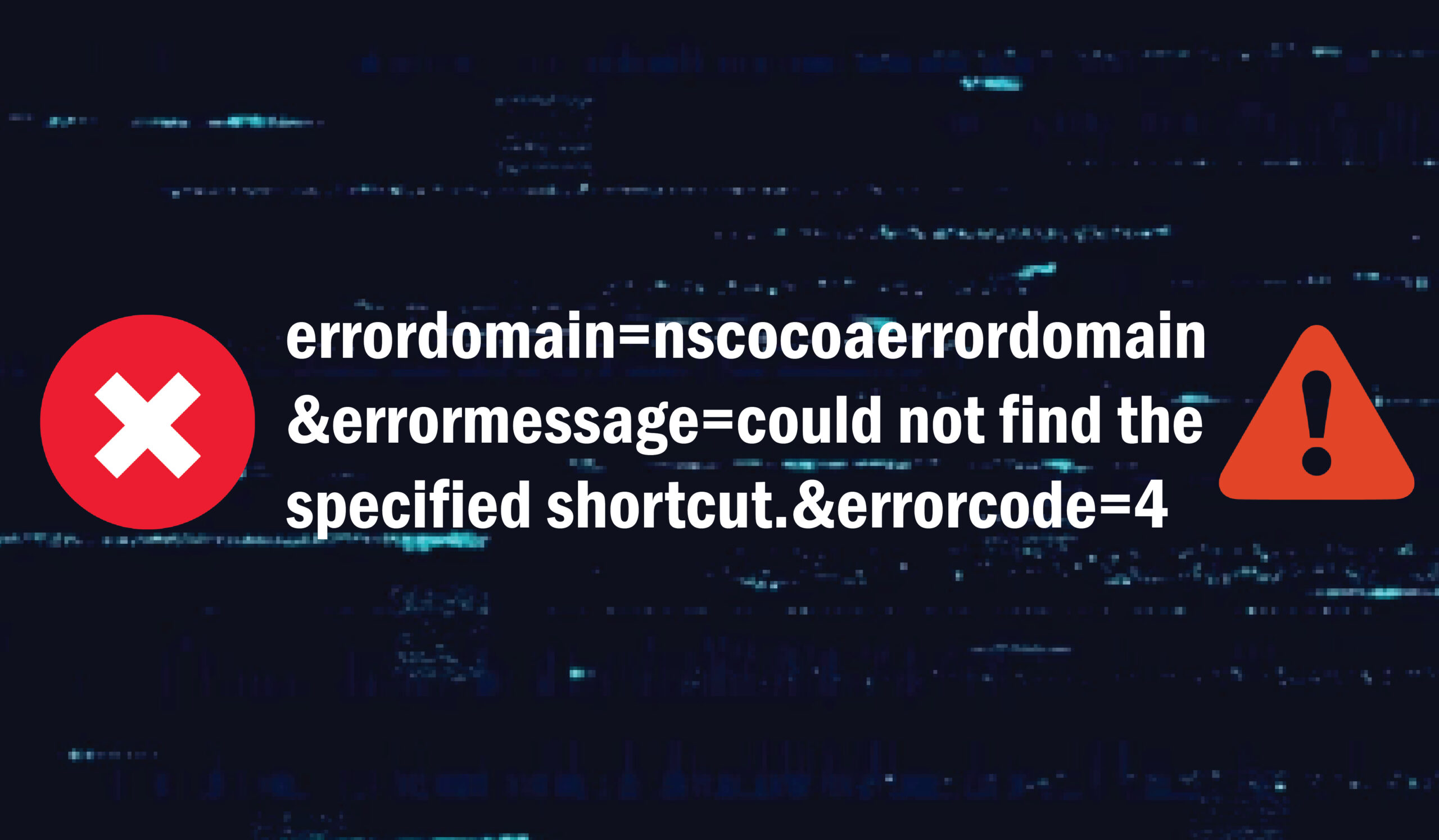Education
Understanding Error Code “errordomain=nscocoaerrordomain&errormessage=could not find the specified shortcut.&errorcode=4”

- /home/u433845138/domains/buzzark.co.uk/public_html/wp-content/plugins/mvp-social-buttons/mvp-social-buttons.php on line 27
https://buzzark.co.uk/wp-content/uploads/2024/11/QQQQ-01-39-1000x600.jpg&description=Understanding Error Code “errordomain=nscocoaerrordomain&errormessage=could not find the specified shortcut.&errorcode=4”', 'pinterestShare', 'width=750,height=350'); return false;" title="Pin This Post">
- Share
- Tweet /home/u433845138/domains/buzzark.co.uk/public_html/wp-content/plugins/mvp-social-buttons/mvp-social-buttons.php on line 72
https://buzzark.co.uk/wp-content/uploads/2024/11/QQQQ-01-39-1000x600.jpg&description=Understanding Error Code “errordomain=nscocoaerrordomain&errormessage=could not find the specified shortcut.&errorcode=4”', 'pinterestShare', 'width=750,height=350'); return false;" title="Pin This Post">
Introduction
In the realm of software troubleshooting, error codes play a vital role in diagnosing issues and ensuring smooth functionality. Apple’s ecosystem, known for its robust Cocoa framework, sometimes generates error messages that are specific to the underlying operations. One such error is “errordomain=nscocoaerrordomain&errormessage=could not find the specified shortcut.&errorcode=4.” Encountering this error can be confusing, especially for non-developers. However, understanding its structure and meaning can simplify the troubleshooting process. This article will break down the error, explore possible causes, and provide steps for resolution.

1. What is NSCocoaErrorDomain?
NSCocoaErrorDomain is an error domain used by Apple’s frameworks, especially within macOS and iOS applications, to classify and report errors that occur during runtime. It groups errors related to Cocoa—the foundational layer of Apple’s operating systems, built on the Objective-C runtime and providing services for app frameworks. Each error code within NSCocoaErrorDomain is associated with specific issues, such as file operations, file permissions, or missing resources.
2. Understanding the Error Code Structure
The error message “errordomain=nscocoaerrordomain&errormessage=could not find the specified shortcut.&errorcode=4” consists of three primary components:
- Error Domain:
errordomain=nscocoaerrordomainidentifies the domain of the error as NSCocoaErrorDomain, which is specific to issues within Apple’s Cocoa framework. - Error Message:
errormessage=could not find the specified shortcutexplains the nature of the problem—the system or application was unable to locate a specific shortcut. - Error Code:
errorcode=4is a unique identifier for the specific issue within the NSCocoaErrorDomain. This code indicates a file-not-found type error that is common when shortcuts point to non-existent resources.
This structure helps users and developers quickly identify the type of error, which in this case suggests that the system could not find a specified shortcut.
3. Possible Causes of “Could Not Find the Specified Shortcut” Error
The error commonly appears in various scenarios where shortcuts or references to files have been modified, deleted, or rendered invalid. Here are some possible causes:
- System or Application Updates: Updates to macOS or specific applications may alter file paths, affecting shortcuts or symbolic links, resulting in a “not found” error.
- File Moved or Deleted: If a shortcut points to a file that has been moved or deleted, the system cannot resolve the shortcut and displays this error.
- Configuration or Permissions Issues: Sometimes, application configuration files or permission restrictions may prevent access to certain paths, resulting in the error.
- Corrupted Shortcut Files: Corrupted shortcut or preference files may also cause this issue, as they can contain invalid paths or data.
Understanding the potential causes is essential for troubleshooting, as it allows users to pinpoint the reason behind the error more effectively.
4. Steps to Troubleshoot Error Code 4 in NSCocoaErrorDomain

This section provides a step-by-step guide on how to troubleshoot and potentially resolve the error.
- Step 1: Verify the Shortcut’s Target Location
- Open Finder and manually navigate to the location where the shortcut’s target file should exist. If the file has been moved, try to relocate it to its original position.
- Step 2: Recreate the Shortcut
- If the target file has been deleted or permanently moved, consider recreating the shortcut by linking it to the correct location. Right-click the target file and choose “Create Shortcut” to make a new link.
- Step 3: Update the Application
- Ensure that both macOS and the application generating the error are up-to-date. Updates often resolve compatibility issues and include fixes for known bugs that might cause shortcut errors.
- Step 4: Check for Permissions Issues
- Navigate to the shortcut’s target file or folder, right-click, and choose “Get Info.” Under “Sharing & Permissions,” ensure that you have the necessary permissions to access the file. Adjust permissions as needed.
- Step 5: Run Disk Utility
- Disk Utility can help detect and repair disk permissions, which may affect shortcuts. Open Disk Utility from Applications > Utilities, select your disk, and choose “First Aid” to check for issues.
5. The Role of Shortcuts in macOS and iOS
Shortcuts, or symbolic links, are widely used in macOS and iOS to provide quick access to files and streamline navigation. These shortcuts play a significant role in applications that rely on frequent access to specific files or directories. However, changes in file structure, application settings, or system updates can disrupt these shortcuts, resulting in the “specified shortcut not found” error.
Apple’s frameworks rely on these links for efficient functionality, so it’s essential to manage them carefully. Users should avoid moving or deleting files that shortcuts rely on and regularly check if shortcuts are functioning correctly.
6. Advanced Troubleshooting and Developer Insights
Developers who encounter this error in their applications may find it helpful to:
- Review Shortcut Dependencies: Ensure that any files or directories linked through shortcuts are available and properly referenced within the application.
- Use Development Tools for Debugging: Tools like Xcode offer logs and debugging capabilities to help identify and fix broken links or missing resources.
- Implement Error Handling: Code that attempts to access shortcuts should include error handling to gracefully manage instances where shortcuts may be invalid or inaccessible.
This proactive approach can reduce occurrences of this error and improve overall app stability.
7. Preventing Similar Errors in the Future
Preventative measures are essential for minimizing the risk of encountering this error. Consider the following best practices:
- Regularly Backup Shortcuts and Files: Regular backups help ensure you have access to original files even if they are moved or deleted accidentally.
- Avoid Unnecessary File Movements: If files linked to shortcuts are regularly used, avoid moving them to other locations.
- Verify Shortcuts after Updates: After major system or application updates, double-check that shortcuts are intact and correctly linked to their target files.
These simple steps can help reduce the risk of encountering errors related to missing shortcuts.
Conclusion
Understanding error codes like “errordomain=nscocoaerrordomain&errormessage=could not find the specified shortcut.&errorcode=4” can demystify the troubleshooting process for both users and developers. By familiarizing oneself with the structure and causes of these errors, effective solutions can be implemented, enhancing user experience and minimizing disruption.
FAQs
- What does NSCocoaErrorDomain mean?
- NSCocoaErrorDomain is a set of error codes used in Apple’s software environment to categorize issues within Cocoa-based applications.
- Why am I seeing the ‘Could not find the specified shortcut’ error?
- This error generally appears if a file linked to a shortcut is moved, or deleted, or the shortcut path is broken.
- How can I fix error code 4 in NSCocoaErrorDomain?
- Start by verifying the file paths, checking for system updates, and, if necessary, recreating the shortcut.
- Is error code 4 specific to macOS, or can it appear on iOS as well?
- Error code 4 can appear on both macOS and iOS, as they share underlying frameworks in Apple’s ecosystem.
- Can developers prevent this error in their applications?
- Yes, by ensuring stable file paths, handling user permissions properly, and testing for shortcut dependencies, developers can minimize this error.
Visit for more Buzzark.
-

 Celebrity11 months ago
Celebrity11 months agoMichael C. Hall: Complex Journey of a Versatile Actor
-

 Business10 months ago
Business10 months agoUnderstanding Apostille UK: A Comprehensive Guide
-

 Technology11 months ago
Technology11 months agoThe Future of Video Marketing: Trends You Can’t Ignore
-

 Celebrity12 months ago
Celebrity12 months agoShane Urban Explained: Facts About Keith Urban’s Sibling
-

 Celebrity12 months ago
Celebrity12 months agoAnuel AA Height and Weight? Everything Age, Bio, Family, and More
-

 Celebrity12 months ago
Celebrity12 months agoWho is Heidi Berry Henderson? Everything About Halle Berry’s Sister
-

 Celebrity12 months ago
Celebrity12 months agoThe Life of Lorenzo Luaces: Lili Estefan’s Ex-Husband Explained
-

 Celebrity1 year ago
Celebrity1 year agoOtelia Cox, Bio Tony Cox’s Wife, Her Age, Height, and Life Journey
-

 Celebrity12 months ago
Celebrity12 months agoian cylenz lee: Bio, net worth, age, family and more Kandyse McClure’s husband
-

 Entertainment1 year ago
Entertainment1 year agoEverything About ‘Oche Oche Anasico’ Lyrics: Meaning, Origin & More
-

 Celebrity12 months ago
Celebrity12 months agoWho is Carolin Bacic? A Deep Dive into Steve Bacic’s Wife
-

 Fashion10 months ago
Fashion10 months agoThe Perfect Pairing: Corset Prom Dresses for a Flattering Fit and Beaver Hat Blanks for Timeless Style


